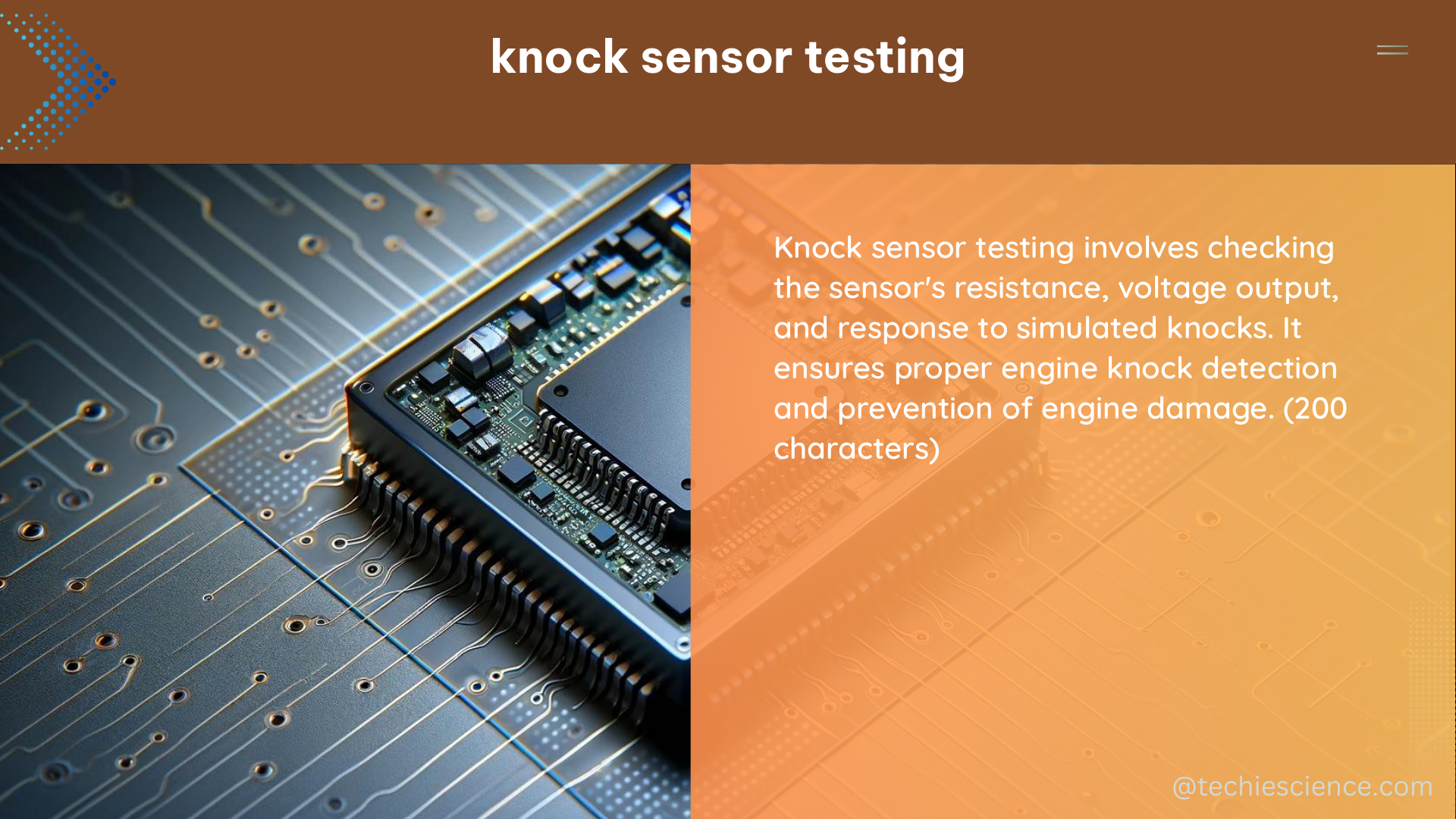Knock sensor testing is a crucial process in evaluating the performance and functionality of a knock sensor, a vital component in the engine control system of an internal combustion engine. This sensor plays a pivotal role in detecting engine knocking, a condition that can lead to severe engine damage if left unaddressed. By understanding the measurable and quantifiable data associated with knock sensor testing, technicians and DIY enthusiasts can ensure their engines operate at optimal efficiency and safety.
Understanding Knock Sensor Sensitivity
The sensitivity of a knock sensor is a crucial parameter in knock sensor testing. This parameter measures the sensor’s ability to detect engine knocking at specific decibel levels or frequencies. Typically, knock sensors are designed to be sensitive to vibrations in the 5 to 20 kHz frequency range, which corresponds to the frequencies associated with engine knocking.
To measure the sensitivity of a knock sensor, technicians can use specialized equipment, such as a knock sensor simulator or a vibration test system. These tools can generate controlled vibrations at different frequencies and amplitudes, allowing the technician to assess the sensor’s response and determine its sensitivity threshold. Ideally, a knock sensor should be able to detect knocking at levels as low as 90 dB, with a sensitivity of around 0.1 to 1.0 volts per g-force of vibration.
Measuring Knock Sensor Resistance

Another important parameter in knock sensor testing is the sensor’s resistance. Knock sensors typically have a resistance range of 5 to 20 kilohms, which can be measured using a multimeter. This resistance value is crucial for the engine control unit (ECU) to properly interpret the sensor’s output signal and make the necessary adjustments to the ignition timing.
To measure the knock sensor’s resistance, the technician can disconnect the sensor from the wiring harness and use a multimeter to measure the resistance between the two terminals of the sensor. If the resistance value falls outside the expected range, it may indicate a problem with the sensor or the wiring, and further investigation or replacement may be necessary.
Analyzing Knock Sensor Output Signals
Knock sensor testing also involves analyzing the output signal from the sensor using oscilloscopes or other diagnostic tools. A properly functioning knock sensor should produce an AC voltage signal with a frequency range of 5 to 15 kHz and an amplitude range of 0.1 to 1.0 volts.
To analyze the knock sensor’s output signal, the technician can connect the oscilloscope to the sensor’s output terminal and observe the waveform. The frequency and amplitude of the signal should be within the expected ranges, and the waveform should be consistent with the engine’s operating conditions. Any deviations from the expected signal characteristics may indicate a problem with the sensor or the engine’s knocking behavior.
Simulating Engine Knocking
Knock sensor testing can also involve simulating engine knocking to evaluate the sensor’s response. This can be done by tapping on the engine block with a hammer or using a specialized tool, such as a knock sensor simulator, to create an artificial knocking event.
When subjected to these simulated knocking tests, a properly functioning knock sensor should produce a clear and measurable AC voltage signal that can be analyzed using a multimeter or oscilloscope. The amplitude and frequency of this signal should be consistent with the expected characteristics of a knock sensor output.
It’s important to note that when testing a knock sensor without running the engine, the accuracy of the test may be limited. Some knock sensors are designed to only listen for knocking during specific crank angles, and a simulated RPM signal, such as that provided by a JimStim, may be necessary to properly test the sensor’s functionality.
Interpreting Knock Sensor Test Results
By analyzing the measurable and quantifiable data obtained during knock sensor testing, technicians can determine the overall health and performance of the sensor. Key factors to consider include:
- Sensitivity: The sensor’s ability to detect knocking at the appropriate decibel levels and frequencies.
- Resistance: The sensor’s resistance value, which should fall within the expected range of 5 to 20 kilohms.
- Output signal: The frequency and amplitude of the sensor’s output signal, which should be consistent with the expected characteristics.
- Response to simulated knocking: The sensor’s ability to produce a clear and measurable AC voltage signal when subjected to simulated knocking events.
If the test results indicate that the knock sensor is not functioning within the expected parameters, further investigation or replacement of the sensor may be necessary to ensure the engine’s proper operation and prevent potential damage.
Conclusion
Knock sensor testing is a critical process in maintaining the health and performance of an internal combustion engine. By understanding the measurable and quantifiable data associated with knock sensor testing, technicians and DIY enthusiasts can effectively evaluate the sensor’s functionality and make informed decisions about its replacement or repair. This comprehensive guide provides a detailed overview of the key aspects of knock sensor testing, equipping readers with the knowledge and tools necessary to ensure their engines operate at optimal efficiency and safety.
References:
– Increasing knock detection sensitivity by combining knock sensor signal with a control-oriented combustion model
– Knock sensor testing and diagnosis
– Seeking alt method to verify knock sensor functionality
– Knock sensor testing and troubleshooting
– Knock sensor testing using a JimStim

The lambdageeks.com Core SME Team is a group of experienced subject matter experts from diverse scientific and technical fields including Physics, Chemistry, Technology,Electronics & Electrical Engineering, Automotive, Mechanical Engineering. Our team collaborates to create high-quality, well-researched articles on a wide range of science and technology topics for the lambdageeks.com website.
All Our Senior SME are having more than 7 Years of experience in the respective fields . They are either Working Industry Professionals or assocaited With different Universities. Refer Our Authors Page to get to know About our Core SMEs.